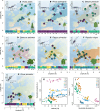Resilience of genetic diversity in forest trees over the Quaternary
- PMID: 39402024
- PMCID: PMC11473659
- DOI: 10.1038/s41467-024-52612-y
Resilience of genetic diversity in forest trees over the Quaternary
Abstract
The effect of past environmental changes on the demography and genetic diversity of natural populations remains a contentious issue and has rarely been investigated across multiple, phylogenetically distant species. Here, we perform comparative population genomic analyses and demographic inferences for seven widely distributed and ecologically contrasting European forest tree species based on concerted sampling of 164 populations across their natural ranges. For all seven species, the effective population size, Ne, increased or remained stable over many glacial cycles and up to 15 million years in the most extreme cases. Surprisingly, the drastic environmental changes associated with the Pleistocene glacial cycles have had little impact on the level of genetic diversity of dominant forest tree species, despite major shifts in their geographic ranges. Based on their trajectories of Ne over time, the seven tree species can be divided into three major groups, highlighting the importance of life history and range size in determining synchronous variation in genetic diversity over time. Altogether, our results indicate that forest trees have been able to retain their evolutionary potential over very long periods of time despite strong environmental changes.
© 2024. The Author(s).
Conflict of interest statement
The authors declare no competing interests.
Figures



References
-
- Birks, H. J. B. & W, T. in European Atlas ofForest TreeSpecies (eds San-Miguel-Ayanz, J., de Rigo, D., Caudullo, G., Houston Durrant, T. & Mauri, A.) (Publication Office of the European Union, Luxembourg, 2016).
-
- Kremer, A. How well can existing forests withstand climate change in: Climate Change and Forest Genetic Diversity: Implications for Sustainable Forest Management in Europe.pp. 3–17. (eds. Koskela, J., Buck, A. & Teissier du Cros, E.), (Bioversity International, Rome, 2007).
Publication types
MeSH terms
Associated data
Grants and funding
LinkOut - more resources
Full Text Sources
Miscellaneous

